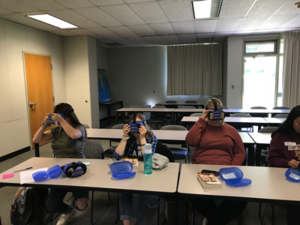I believe in using technology to engage all learners. After spending 15 years as an elementary teacher and now as a college professor, I see the same learning needs and teaching frustrations. This column is based on the premise that everyone can learn and often technology can provide just the right learning support.
While teaching in an inner-city school, I had a student named Eddie, who was bright, funny, and an amazing artist. According to our testing, he was a pretty good reader too, though he absolutely refused to read. He was impatient and distracted and couldn’t or wouldn’t read in class. I read about digital books engaging reluctant readers and a light bulb went off. I wrote a grant, got some iPads, and began a class read along where students alternated between traditional books and digital books on the iPads. Eddie read—and he enjoyed it. It was a new and exciting experience. A game changer for Eddie and others like him.
Flash forward a couple of years. My daughter, who has a learning disability, was a college freshman in an intro to human behavior class and struggling with her big, traditional textbook. She spoke with her professor and discovered that there was a website for the text with videos that supported the concepts. She called me and said, “Mum, the reading was so much easier when I read, then watched the video—it made sense!” As an educator and parent, I could see the technology opening a door for my child.
Now that I’m a college professor, I incorporate technology into my courses all the time. Recently, my students created their own online quiz to demonstrate their knowledge of the reading. It was an instant success. One student said, “This was awesome! I felt like a professor getting ready to test my students and I knew I really had to know the material before I could test someone else.”
I see the power of technology and how it can open doors for students who may need their content presented in an alternate way. Our classrooms are full of learners like Eddie and my daughter, and all the other students who may need and deserve material presented in an engaging and accessible way.
I’m writing this column to share cool tech tools and to share great tech-enriched teaching strategies that can make a difference in all our students’ lives. I hope you enjoy.
Faculty often ask how they can engage students in the content they are teaching. They’re wondering how they can use technology in a meaningful way to cover the material and reach students who are not engaged or are struggling with comprehension.
VR comes to my class
My latest obsession (besides Queer Eye and the Red Sox) is Google Expeditions. I can’t say enough about it as a tool for experiencing and learning within every subject.
Google Expeditions can be a fairly inexpensive way to present content. Students who have smartphones (Android or iOS) can download the Google Cardboard app and Google Expeditions for free. VR glasses can improve the experience but are not required. Instructors can serve as guides with students joining expeditions or you can assign an expedition and have students explore on their own.
Ideas for using VR in class
- Do you teach biology? Take them on a tour of a virus or a cell.
- Are you a professor in the arts? Visit street art around the world or the Royal Shakespeare Company.
- Are you a guidance or career counselor? Bring your students to Berklee College of Music or meet a robotics engineer or female firefighter in NYC.
- Astronomy professor? Send your students on the Juno mission to Jupiter or to experience the aurora borealis.
- Professors of education can build lessons with your students so they can teach elementary students about animal camouflage or take children on a tour of the Aztec and Mayan pyramids.
There are hundreds of Expeditions and more are added every day. The guided experience is the best. As a guide, you can have your students join your Expedition during which you can point out notable sites.
For those of us who can always use a little questioning help, Expeditions provides prompts and background about the Expeditions based on student levels. I used it with my students and during our “climb” of Mt. Everest we discussed the cultural and environmental implications of this kind of tourism. My students engaged in great conversation about what they saw, but for me the real power came from my teacher-candidate students discussing how they will use Expeditions in their classrooms.
With or without VR glasses, using Google Expeditions in your classroom is a terrific experience.
Follow me on Twitter @careyingle or on Instagram @teachingandlearningwdringle and see how I’m using tech in my classes!
- 5 terrific edtech tools for creating a highly engaging online (or hybrid) course - February 13, 2019
- It’s a website … it’s a portfolio… Whatever it is, it’s much better than a resume - January 3, 2019
- Have you taken the Kahoot Challenge? - December 6, 2018


